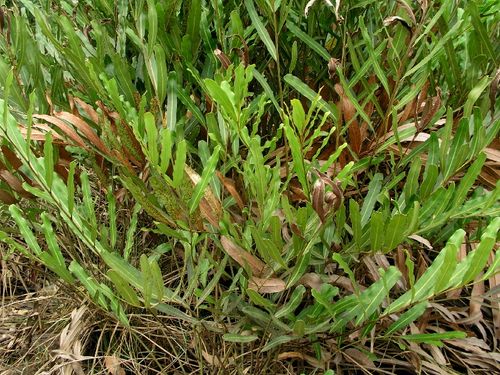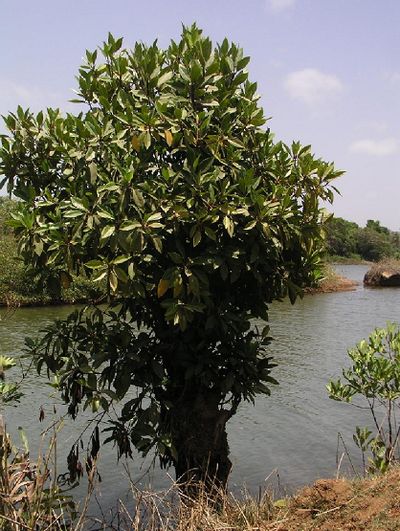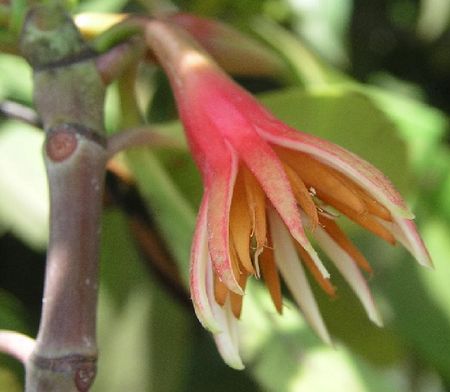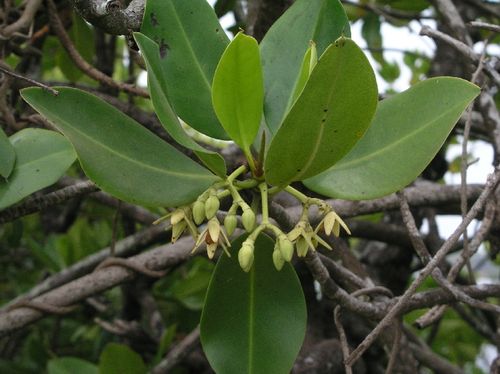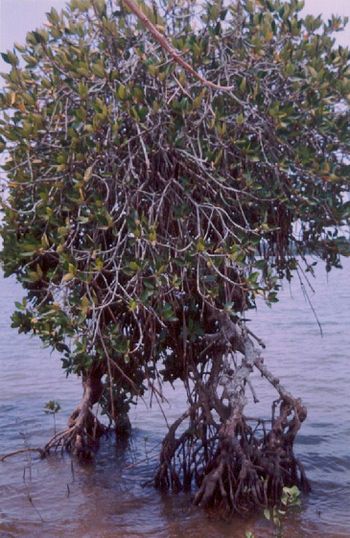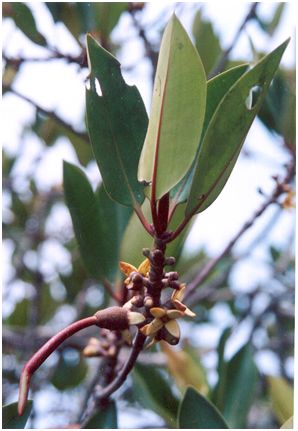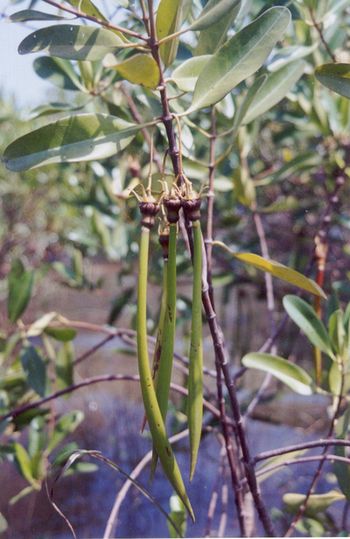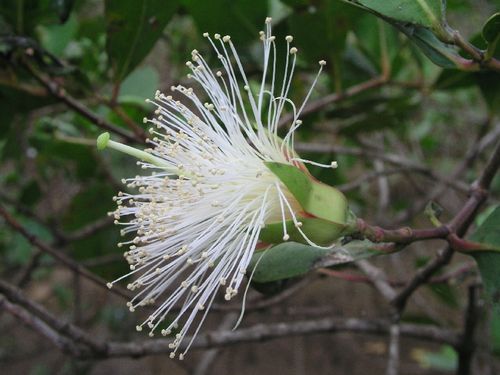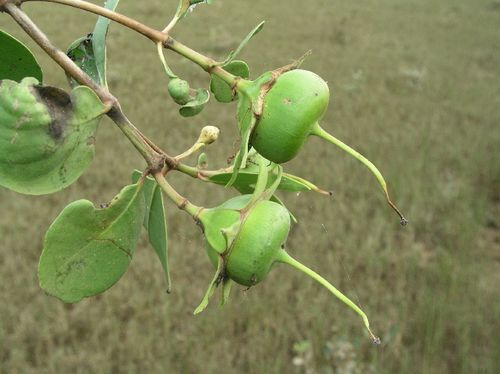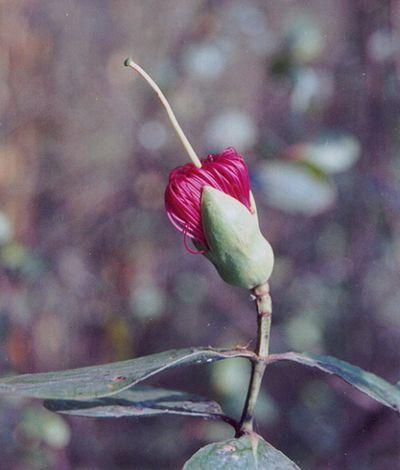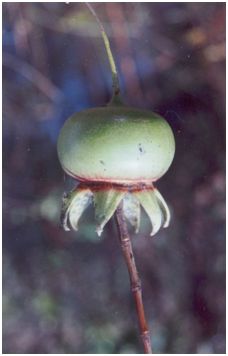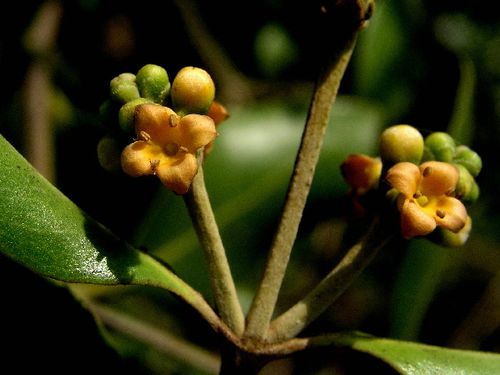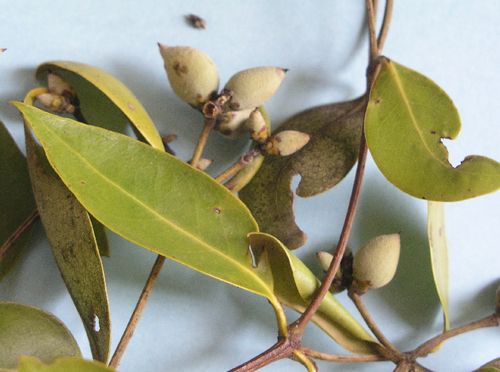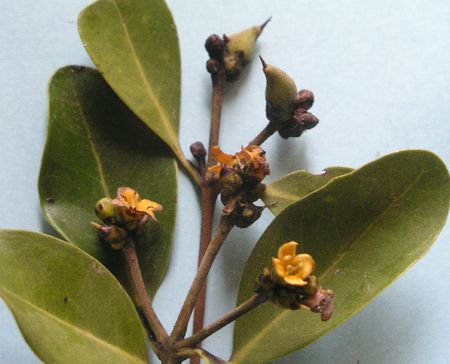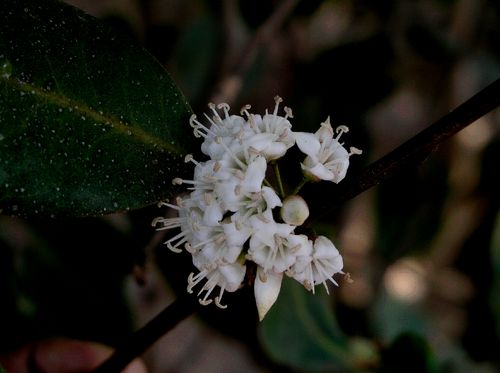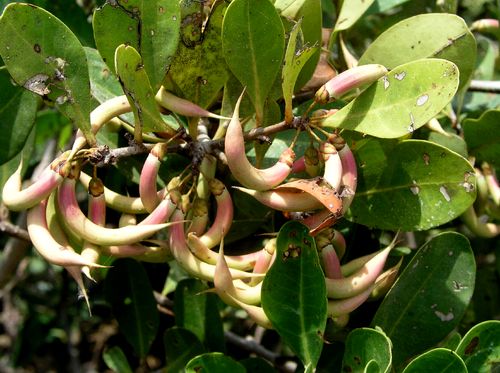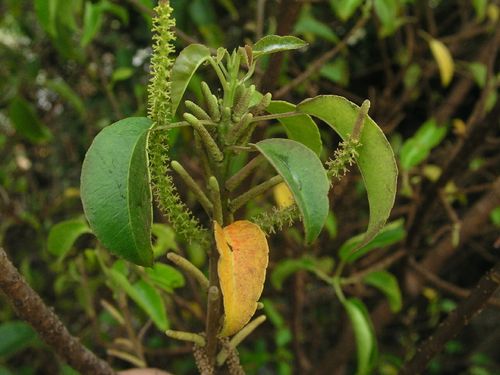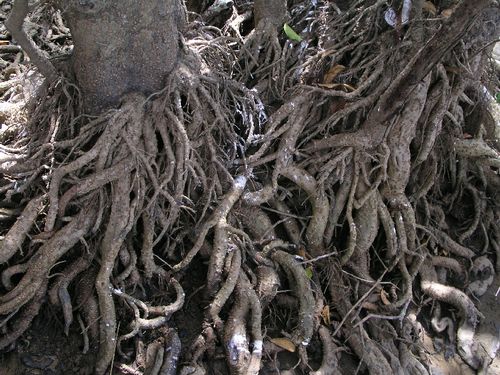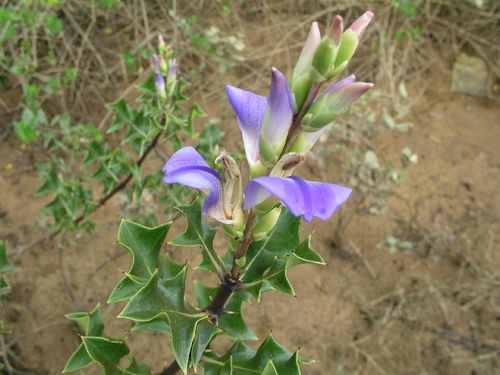Energy and Wetlands Research Group, Centre for Ecological Sciences, Indian Institute of Science, Bangalore – 560012, India.
*Corresponding author: cestvr@ces.iisc.ac.in
IDENTIFICATION OF MANGROVES Most mangroves are woody plants, shrubs and trees. There are also few herbs, mainly some grasses and sedges. Among the woody plants one is a lower plant- a fern namely Acrostichumaureum(Figure2.1); this fern grows in colonies in swampy and marshy places where the tidal force is low and salinity is not that high. The important mangrove families and their members found in Honavar Forest Division are described here. I. TRUE MANGROVES Family: Rhizophoraceae This is the most important family of mangroves. The members are woody plants, usually trees. The family has spectacular development of aerial stilt roots. These roots spring from the main stem and also the branches; they branch repeatedly and grow downwards and give additional support to the tree in the soft mud. The aerial roots, studded with tiny air passing windows known as lenticels, visible to the naked eye, also help in aeration. The trees have opposite, simple, dark green leathery leaves. The terminal bud is protected by a long cover made up of stipules. These stipules fall off when new leaves emerge. The members of the family produce from the fruits long, green, cylindrical propagules. These on maturity detach from the fruit and fall vertically into the mud, where they strike roots and become daughter plants. If the propagules happen to fall when the substratum is flooded during high tides they may be carried away by water currents; Onreaching suitable swampy places they develop into new plants. This interesting phenomenon of reproduction is called ‘vivipary’. Here apparently the mother plant is giving birth to daughter plants. Members of Rhizophoraceae can be identified using the following key: Calyx 8-16 lobed; petals 2 lobed : 1. Bruguiera Calyx 4-6 lobed; petals not lobed: Calyx 4 lobed; petals without apical outgrowths : 2. Rhizophora Calyx 5-lobed; petals with apical outgrowths;
We have only one species in the Honnavar Forest Division, namely B. gymnorrhiza. It is a tree with rough corky bark; stem base may be flattened into buttresses. Leaves elliptic to oblong elliptic with a narrow tip; but not ending in a narrow long point as in Rhizophora.Leaf size 7-14 cm by 4 to 6 cm. Leaf stalks and midrib red coloured.Flowers in singles, reddish coloured; calyx 10-16 lobed, red to pinkish; petals bilobed, outer margin with silky hairs. The fruit produces a propagule of 10-15 cm. which is slightly angled (Figures 2.2-2.3).Small trees were found at Hegle in Venktapur river of Bhatkal. In Andamans it grows to 36 m, and is buttressed.
R. mucronata: Trees reaching maximum height of 10 m in the Division. Numerous branched stilt roots arise from the base of the stem. Some arise from the branches also. Leaves 10-18 cm X 4-10 cm, broad and elliptic; the leaf tip is produced into a narrow outgrowth called mucro; leaf base blunt to obtuse. Flowers are produced in long clusters, each cluster having 4-8 flowers. Petals are hairy and stamens 8. The propagule, a long green, smooth cylindrical structure, reaches a maximum length of 65 cm (Figure 2.4). Note: Both Rhizophoramucronata and R. apiculataare found in the Division. The former is the commoner and widely used for afforestation. R. apiculata: A smaller tree, reaching 4-5 m in the Division. Stilt roots arising from main stem as well as from branches form impenetrable barrier beneath the canopy. Leaves elliptic lanceolate with a smaller narrow bristle like point towards the narrow tip. Size 10-20 cm X 5-8 cm. Leaf base conical; leaf middle vein reddish. Flowers in pairs in upper leaf axils, without stalks; petals not hairy; stamens 12.Propagules30-50 cm long (Figures 2.5, 2.6).
Small trees reaching 5-6 m high. Leaves narrower than Rhizophora, oblong shaped. Flowers white, in dichotomously branched inflorescence axis. Calyx 5 lobed, reflexed; petals 5, divided into numerous fine branches.Stamens numerous.Propagule cylindrical, green, narrowed towards the tip, 30-40 cm long. The trees have flesh coloured base flattened into buttresses; stilt roots closely adpressed to the stem base. Bark reddish brown, peeling off into flakes (Figure: 2.7) Note: Found commonly in all estuaries Family: Sonneratiaceae Sonneratiaalba: Small trees reaching maximum of 5 m. Many corky pneumatophores stick out of the mud from all around the tree. Leaves opposite, elliptic, oblong, blunt at apex, narrowed at base; Flowers 2-3 together; calyx has a cup shaped part and 6-8 lobes which are distinct in fruit. Petals white, small; stamens numerous, free, white; ovary depressed globose. Fruit somewhat spherical, many seeded with calyx remaining in the fruit. Natural regeneration is plentiful especially in shallow places with low tidal effects (Figures 2.8-2.9). Note: Found in all rivers except Sharavathi Sonneratiacaseolaris: Trees up to 12 m height; soft corky pneumatophores longer than S. alba, reaching up to 1 m. Young stem 4-angled. Leaves almost without stalk, much narrowed at base, opposite. Leaf tip has a pore known as hydathode through which excess salt is secreted. Flowers reddish purple, in singles at the tip of branches; stamens numerous, reddish. Fruits depressed globose (Figures 2.10-2.11) Note: Most common mangrove tree in Sharavathi; Rare in other rivers; not found in Gnagavali, although Rao& Suresh (2001) present it as a cpmmon species there. It prefers places with low salinity; the Sharavathiriver, where fresh water from the dams is constantly released appears to be ideal for it. Family: Avicenniaceae Avicennia marina: Shrubs or small trees upto 4 m high. Bark smooth yellowish brown. Leaves 3-6 X 2.2.5 cm, elliptic oblong or ovate, narrowing to an acute tip; leaf base rounded or narrowing. Flowers small, stalkless, yellowish clustered towards tips of floral axis; stamens not projecting out from the corolla. Fruit at maturity ovoid with a pointed tip, slightly flattened (Figures 2.12, 2.13). Note: Very common in Gangavali, rare in Aghanashini, common in Alvekodi creek, absent in Sharavathi and Badgani, moderate in Venktapur. Avicenniaofficinalis: Larger trees, reaches 8-10 meters in Honavar Forest Division; exceptional individuals of 12 m are found in the sacred grove of Masurkurve in Aghanashini. Smooth whitish gray bark; pneuatophores seen all around the tree. In addition masses of branching stilt roots hang from the upper part of the trunk and base of large branches. Leaves 5-7.5 cm X 2.5- 3.25 cm, ovate, oblong with more or less rounded leaf tip.Small, yellow stalkless flowers seen in clusters towards the tip of floral axis. Flowers distinguished from A. marina by stamens seen projecting outside the corolla (Figures 2.13-2.14) Note: Found in all the rivers of the Division. Family: Myrsinaceae Aegicerascorniculatum: Shrubs or small trees with slender stilt roots. Leaves 4-8 cm X 2-4 cm, alternate, ovate-oblong or obovate, may have a small notch at the blunt tip; leaf base cone like. Flowers small, white, fragrant in umbellate bunches. Propagules which come out of the fruits are 3-4 cm long and curved with pointed tips (Figures 2.15-2.16). Notes: Found in all estuaries along edges and banks away from strong tides; notable for fragrant white flowers Euphorbiaceae Excoecariaagallocha: Large shrubs or small trees occurring along the edges of the swamp, on bunds and on wet soils. Acrid, blister causing latex present. Numerous serpentine roots produced from base of stem. Leaves alternate, margins entire or mostly minutely toothed; leaves turn red before shedding (Figures 2.17-2.18). AcanthaceaeFamily of herbs and shrubs.Flowers not regular in shape. Acanthus ilicifolius: A shrubby plant growing in colonies in shallow parts of the swamp. Leaves opposite, stiff, wavy and with sharp spines along the margin.Flowers large, blue (Figure 2.19) Poaceae Porteresiacoarctata: A stiff erect grass growing in meadows in open shallow parts of the estuaries (Figure 2.19) II. MANGROVE ASSOCIATES Numerous species of plants occur in association with the mangroves. These are not obligate mangroves and higher salinity is not often a prerequisite for their growth. They may also be often associated with inland habitats. These plants have certain degree of salinity tolerance. They often grow along the margins of swamps, or on estuarine bunds. Details of notable mangrove associates are found in Table 2.1. Table 2.1. Details of notable mangrove associate species in Honavar Forest Division
Mangrove Species
|


